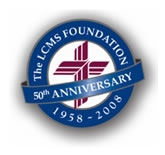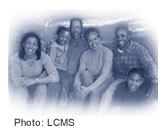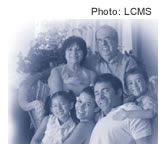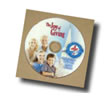by Roland Lovstad
In 1958, a “mission statement” was absent from the vocabulary of seven men who gathered during August to draft the articles of incorporation for the LCMS Foundation.
Those founders must have envisioned the Synod’s mission statement—adopted some four decades later—“to vigorously make known the love of Christ, by word and deed, within our churches, communities, and the world.”
Could they have imagined that $1 billion would be distributed for missions, world relief, human care, higher education, congregations, schools, and other ministries? Could they have imagined the extent of partnerships the Foundation would foster between faithful Lutherans and ministries in the name of Jesus Christ?
 “The 50 years are not about us as an institution. . .or about the money. They’re about the joy of giving,” says Rev. Thomas Ries, Foundation President. He believes the Foundation has its calling and mission in financial stewardship, adding, “It is the only LCMS organization that offers comprehensive charitable expertise and services to help members plan and direct their passion for giving to family and all ministries of the church today, tomorrow, and forever.”
“The 50 years are not about us as an institution. . .or about the money. They’re about the joy of giving,” says Rev. Thomas Ries, Foundation President. He believes the Foundation has its calling and mission in financial stewardship, adding, “It is the only LCMS organization that offers comprehensive charitable expertise and services to help members plan and direct their passion for giving to family and all ministries of the church today, tomorrow, and forever.”
When the Foundation was organized, The Lutheran Church—Missouri Synod was growing. It was the Baby Boom, and many young families were finding jobs, buying station wagons, and moving to the suburbs.
Speaking to the founding committee, member Leslie Allenstein cited needs for pastors and teachers, scholarships, college and seminary facilities, adequate churches, and care for the sick and elderly. “Where we are educating hundreds of students, we should be training thousands,” he said. “Instead of opening 135 new missions a year, we should be thinking in terms of 1,000.”
In the Foundation’s early days, Dr. Eugene Bertermann served half-time as executive director. Members of the board of trustees, volunteers, even LCMS President John W. Behnken, visited donors, spoke to meetings and conventions, and assisted in presentations on wills. Gift annuities were advertised in The Lutheran Witness and processed by mail. Donations of homes or farms sometimes included provisions of life tenancy for the donors.
The small staff sought to gain visibility for the Foundation and to explain the potential of Christian wills and Christian estate planning. By the end of fiscal year 1961, the Foundation’s worth exceeded $500,000; the following year it approached $1 million.
While the assets of the Foundation grew, the wealth of Lutherans also grew as the value of their homes, farms, businesses, property, and investments increased.
 In the ’70s, the Foundation offered estate planning meetings and materials. Workshops were provided to development officers at colleges and agencies. New instruments, such as the unitrust, enabled donors to give appreciated assets to the church, decrease capital-gains taxes, and receive life incomes for themselves and even family members.
In the ’70s, the Foundation offered estate planning meetings and materials. Workshops were provided to development officers at colleges and agencies. New instruments, such as the unitrust, enabled donors to give appreciated assets to the church, decrease capital-gains taxes, and receive life incomes for themselves and even family members.
A major catalyst came in 1979 when the LCMS convention approved Forward in Remembrance, a campaign to raise $40 million for missions and higher education. Assisted by a professional fund-raising company, the campaign employed full-time staff, plus volunteers, to visit potential donors and make gift requests. Two years later, Forward in Remembrance reported nearly $75 million in gifts and pledges—the most successful national campaign of any church denomination at the time.
In 1981, the convention established the Department of Stewardship and Financial Support as the development arm of the Foundation. Over the next years, gift-planning counselors were deployed throughout the country in cooperative arrangements with districts, colleges, and service organizations. The counselors offered wills-awareness seminars in congregations and helped individual members with gift arrangements. In St. Louis, staff developed stewardship resources for congregations and designed methods to gather direct gifts to support seminaries, missions, and world relief.
The process bore fruit. During the 1991–92 fiscal year, the Foundation distributed $9.6 million to synodical ministries. That year, the staff reported 243 congregational seminars and 4,815 home visits.
Seeking to establish a single stewardship center in 1992, the convention transferred planned-giving services and development services to the Foundation. It also approved a new Capital Funding Services to assist congregations with capital and debt-elimination campaigns. (The unit assisted 300 congregations before being moved to the Lutheran Church Extension Fund in 1999.)
 Reflecting technical advancements, the Foundation opened a Mission and Ministry Online Giving Catalog four years ago. The catalog now lists 400 giving opportunities of Synod-related ministries. “With Internet access, people can learn about ministry opportunities and support them from the comfort of their homes,” comments Blake Tilley, director of Internet and gift-planning communications.
Reflecting technical advancements, the Foundation opened a Mission and Ministry Online Giving Catalog four years ago. The catalog now lists 400 giving opportunities of Synod-related ministries. “With Internet access, people can learn about ministry opportunities and support them from the comfort of their homes,” comments Blake Tilley, director of Internet and gift-planning communications.
Through the Foundation’s “Transfer the Blessings” gift-planning and stewardship process, gift-planning counselors train congregational teams in the basics of charitable gift planning. The process helps members plan the best gifts for their families and the best gifts for the ministries they love.
Terry Gerdts, senior vice president for gift-planning services, recalls 20 years of sitting across the kitchen table, helping people. “When we ask them what they believe is the gift plan God has placed on their hearts, they can readily share how they would like to bless their family and God’s work,” he says. “I have seen how a plan developed years ago has come into being at the death of a donor—to the extent that a gift has matched dollar-for-dollar the need of the designated ministry.”
Adds Foundation President Ries: “Decision makers are Christians who have gifts they have received from the Lord that they can use for ministry. We have an overriding strategic goal to increase the number of face-to-face encounters with those decision-makers. We’re working hard to get people into a comfort zone so they can experience the joy of giving.”
Generosity Extends Mission and Ministry
As the Lcms Foundation celebrates its 50th anniversary, the impressive achievements are a tribute to the people of the synod whose joy in giving responds to god’s love in Jesus christ.
Gifts Today. Direct gifts support current ministries such as relief to disaster victims or support where needed at the seminaries. During the 2006–2007 fiscal year, 160,000 direct gifts supplied $48 million for immediate support of ministries.
Gifts Tomorrow. Through wills and gift instruments Christians used the Foundation to distribute 5,787 matured charitable gifts—almost $28 million for mission and ministry. They also placed 1,849 planned gifts of nearly $60 million to be distributed in the future.
Gifts Forever. Endowments preserve the principal while distributing the earnings, allowing donors to establish perpetual support for ministries. The foundation manages more than $350 million in endowment accounts.
 Foundation assets exceed $830 million, including endowment accounts, trusts, annuities, and other instruments destined to assist the future work of the church.
Foundation assets exceed $830 million, including endowment accounts, trusts, annuities, and other instruments destined to assist the future work of the church.
For information about the Foundation, see www.lcmsfoundation.org or call (800) 325-7912 to receive a free copy of the 50th anniversary DVD, The Joy of Giving.





